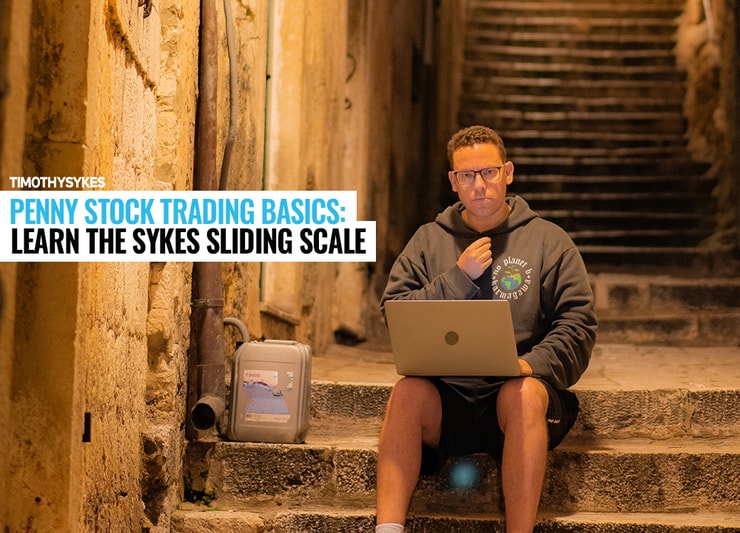Learn the Sykes Sliding Scale: Key Takeaways
- The Sykes Sliding Scale distills years of experience into a simple strategy to pre-grade trades.
- It can help you avoid making stupid mistakes and modulate position size.
- The Sykes Sliding Scale takes your personal schedule into consideration. That’s key for new traders.
Watch the Original “Trader Checklist” Guide for FREE
The Sykes Sliding Scale has seven indicators. The number of questions I get from students focused on one indicator is crazy. You can’t focus on only one aspect of trading and expect to do well. Even if you win on several trades, you’ll learn the wrong lessons. In the end, it will come back to haunt you. Here’s a thorough approach to every single trade…
Table of Contents
What Is the Sykes Sliding Scale?

When I started teaching, I needed a simple explanation for my trading thought process.
- Why do I choose a stock?
- What’s the pattern?
- And how do I determine position size?
You must PREPARE for every trade — that’s actually a handy acronym for the sliding scale. Let’s break it down…
What You Need to Know to P.R.E.P.A.R.E. for a Trade
The key to using the Sykes Sliding Scale is to prepare ahead of time. Again, I’ve been doing this so long that it’s second nature to me.
If you want to get good at it, you’ll have to practice. There’s no ‘easy’ button.
P Is for Pattern and Price
What’s the pattern? What’s the price in relation to the pattern?
Too many newbies buy anything that’s spiking. Don’t get me started on short sellers. They want to short anything that’s up. It’s crazy.
Always look for a clear pattern. At first, you’ll have to test and tweak. That’s trading.
R Is for Risk/Reward

What’s the risk/reward ratio?
I don’t like to trade something unless there’s potential for a decent gain. I’m not looking to risk 5 cents a share for a possible 10-cent gain. That 1:2 risk/reward isn’t enough for me. I’m looking for 1:3 or 1:4. (Or better.)
E Is for Ease of Entry and Exit
- How easily can you get in and out of your position?
- What’s your position size in relation to the average trading volume?
- What’s your position size in relation to the current trading volume?
- How fast is the stock moving?
You don’t want to get stuck in an illiquid stock. I learned my lesson the hard way on the biggest loss of my career. (Read about that when you grab your no-cost copy of my autobiography here.)
Also, with fast-moving or choppy stocks, you might have to account for slippage.
P Is for Past Performance and History of Spiking
You should always check to see if a stock has a history of spiking. A lot of stocks come into play again and again. If I’ve traded a stock in the past, I remember. But I still check to see if it has a history of spiking, gapping up, or multiday runs.
I’m a glorified history teacher. You MUST study stock market history if you want long-term success in trading. That includes individual stocks.
A Is for At What Time and Personal Schedule

This is SO important. You need to make trading fit your lifestyle. For me, I love to travel. And I spend time on my charity. Normally, I’m not sitting in front of the screen all day watching the markets.
For you, it might be different. If you’re working a full-time job, you have to respect that. If you have an appointment at 10 a.m., you probably shouldn’t get into a trade at 9:59…
Also, time of day matters. I rarely trade premarket or after hours. I don’t like trading midday. For me, the best time to trade is during the power hours.
R Is for Reason or Catalyst
Why is the stock moving? Again, I avoid buying random spikers. Does that mean I never buy a stock without an obvious catalyst? No. Sometimes I do. But that affects my position size. It affects how long I’m willing to hold.
You need to study to know what news has the potential to move stocks…
Start with my no-cost “Holiday Trading Guide.” Then add StocksToTrade Breaking News to your subscription. It’s my go-to tool for learning what’s moving stocks today.
E Is for Environment of the Market
Three out of four stocks follow the overall market.
- Is it a bull market or bear market?
- Is there some big news about jobs?
- Are we in earnings season?
- What’s the market sentiment?
You need to understand what’s going on. It might not directly affect the stock you want to trade, but it will help inform your decisions.
3 Benefits of Using the Sykes Sliding Scale

Many students use the Sykes Sliding Scale to decide if a setup has potential. But there are other benefits, too.
Here are three that go beyond just getting into a trade in the first place.
Use the Sykes Sliding Scale to Modulate Position Size
This is worth mentioning again. Many traders determine position size based on the size of their account or how much they’re willing to lose. And both are valid.
But using the seven indicators can help you refine on a trade-by-trade basis. Sometimes it pays to take a speculative position. At the same time, you can reduce risk by taking a smaller size.
Use the Sykes Sliding Scale to know when to size down — or when to size up in a hot market.
More Breaking News
- BigBear.ai’s Journey in the Stock Market: Rising Trends and Challenges
- Top Bitcoin Stocks to Watch Under “Crypto Emperor Trump”
Use the Sykes Sliding Scale for Trade Reviews
Reviewing trades is essential to refining your process over time — especially on a loss.
You might see something you missed that explains why. Use the scale to post-grade your trades. It gives you deeper insight into your ability to read the indicators.
Use the Sykes Sliding Scale to Track Data

I don’t use spreadsheets, but a lot of my students do. You could set up your tracking spreadsheet to include the seven indicators in addition to other data. That way it’s part of your pre-trade process, your post-trade review, and your tracked data. Now THAT would be powerful.
To see how millionaire traders track data, watch the monthly recaps by Kyle Williams, Mariana Hincapie, and Jack Kellogg. (Be sure to hit ‘like’ and ‘subscribe’ while you’re there.)
Also, watch this webinar by Tim Grittani. (You have to be a Trading Challenge member to watch it. Get in.)
How to Learn the Sykes Sliding Scale In-Depth

Now you know my seven indicators, but I’ve barely scratched the surface. To really get it and put it into practice, you need more information. It’s a sliding scale … meaning every trade is different.
Start here…
The Complete Penny Stock Course
Read “The Complete Penny Stock Course” by my student Jamil. It’s still basic when it comes to the Sykes Sliding Scale, but it puts it into context.
You’ll learn my favorite patterns and the catalysts I like. It’s a must-read book with answers to the most frequently asked questions. (You’ll find the Sykes Sliding Scale in Chapter II:11 Sykes Sliding Scale — page 235.)
Trader Checklist Part Deux
If you really want to burn it into your brain, watch my “Trader Checklist Part Deux” DVD. Watch it multiple times. (Trading Challenge students already have access.)
Trader Checklist
Trader Checklist Part Deux takes it to the next level. But all the basics are in the original. The best part? It’s 100% FREE. Watch it twice before we put it behind a paywall again.
More Trading Education

The Sykes Sliding Scale is the result of years of trading experience. It was me taking a step back and asking myself, “What am I thinking and why?”
Now, over 11 years later, it still works for me. So use it. Again, I’m not always right. And I still have to follow my rules — especially rule #1: cut losses quickly. (I trade using these rules.)
Trading Challenge
All my top students are in the Trading Challenge. If you’re ready to get busy, study your butt off, and learn the nuances of trading, apply here today. Fair warning: not everyone gets accepted and no lazy losers allowed.
What do you think of the Sykes Sliding Scale and preparing your trades ahead of time? Comment below, I love to hear from all my readers!




Leave a reply